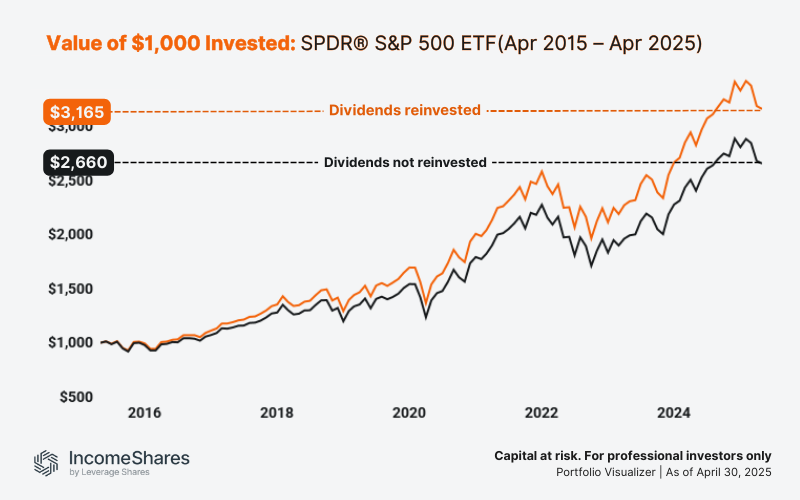.webp)
Auteur
Jonathan Hobbs, CFA
Date
12 May 2025
Catégorie
Market Insights
Reinvesting Dividends Makes a Difference
Votre capital est exposé à un risque si vous investissez. Vous pouvez perdre la totalité de votre investissement. Veuillez consulter l’avertissement complet sur les risques ici

Most investors know that dividends matter. But what’s less obvious is just how much difference reinvesting them can make over time. Take the SPDR® S&P 500 ETF Trust (SPY). It’s one of the most widely held ETFs in the world, tracking the performance of the S&P 500 Index.
Example: Dividends reinvested vs not reinvested in the SPY
Between April 2015 and April 2025, if an investor simply held the SPY without reinvesting dividends, it returned 10.30% per year – turning $1,000 into $2,660.
With dividends reinvested, the return rose to 12.20% per year – growing that $1,000 to $3,165 (source: Portfolio Visualizer).

Why this matters for income strategies
This shows the power of compounding. Each reinvested dividend bought more shares, which then earned more dividends – creating a snowball effect.
For income-focused investors, it also illustrates a potential trade-off: spending the income may reduce long-term total returns.
The IncomeShares approach
The IncomeShares S&P 500 Options (0DTE) ETP (SPYY) aims to generate monthly income by selling daily put options on the S&P 500 Index or the SPY ETF. That income is not automatically reinvested back into the ETP.
Key takeaway
- Reinvesting dividends may boost long-term returns through compounding.
- Income strategies like SPYY aim to pay out monthly income – and do not automatically reinvest income.
- Income-focused strategies may involve trade-offs between regular payouts and long-term growth.
Votre capital est exposé à un risque si vous investissez. Vous pouvez perdre la totalité de votre investissement. Veuillez consulter l’avertissement complet sur les risques ici
Produits associé:
Stratégie
Option de vente couverte par liquidités + actions
Rendement des
distributions
41.58%
